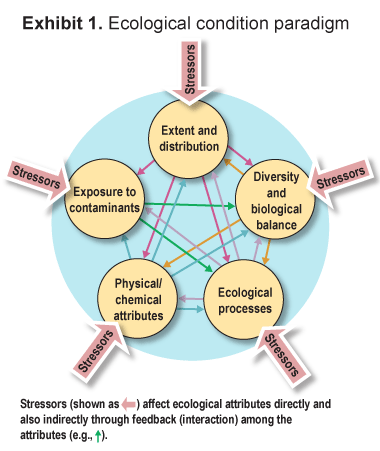Ecological Condition

“Ecological condition” refers to the state of ecological systems, which includes their physical, chemical, and biological characteristics and the processes and interactions that connect them. Understanding ecological condition is crucial, because humans depend on healthy ecological systems for food, fiber, timber, flood control, and many other benefits.1 Many Americans also attribute deep significance and important intangible benefits to ecological systems and their diversity of plants and animals.2 EPA, other federal agencies, and state agencies collectively bear responsibility for ensuring that ecological systems are conserved.
An “ecological system” (ecosystem) is a biological community consisting of all the living organisms (including humans) in a particular area and the nonliving components, such as air, water, and mineral soil, with which the organisms interact. Ecosystems do not always have clear-cut boundaries.
For example, where does a forest end and a meadow begin, or the coastal saltmarsh end and the freshwater marsh begin? Many ecosystems are defined based on their predominant species (e.g., forested ecosystem) or physical characteristics (e.g., stream ecosystem), with the boundaries established to follow a set of scientific or management rules or protocols.
Examples of ecological systems3 include forests, grasslands, agricultural systems, lakes, streams, wetlands, estuaries, and coral reefs. Ecosystem processes cycle water and nutrients, build soils, produce the oxygen we breathe, remove carbon dioxide and other greenhouse gases from the atmosphere, and perform many other functions that are important for the health of people and the planet.
EPA's mission is “to protect human health and the environment.”4 The ROE indicators of ecological condition address five fundamental questions about the state of the nation's ecological systems, providing insight into the degree to which the natural environment is being protected:
Indicators: Extent and Distribution
- What are the trends in the extent and distribution of the nation's ecological systems? This question examines trends in the overall extent (area and location) of different kinds of ecological systems. It also examines spatial patterns in the distribution of ecological systems that affect interactions of nutrients, energy, and organisms.
Indicators: Diversity and Biological Balance
- What are the trends in the diversity and biological balance of the nation's ecological systems? This question explores trends in the types and numbers of species that live within ecological systems and how they interact with each other.
Indicators: Ecological Processes
- What are the trends in the ecological processes that sustain the nation's ecological systems? This question focuses on trends in the critical processes that sustain ecological systems, such as primary and secondary productivity, nutrient cycling, decomposition, and reproduction.
Indicators: Physical and Chemical Attributes
- What are the trends in the critical physical and chemical attributes of the nation's ecological systems? Physical attributes can include temperature, hydrology, and physical habitat, as well as major physical events that reshape ecological systems, such as fires, floods, and windstorms. Chemical attributes can include pH, dissolved oxygen concentrations, and nutrients (e.g., nitrogen and phosphorus).
- Acidity in Lakes and Streams
- Hypoxia in Gulf of Mexico and Long Island Sound
- Nitrogen and Phosphorus in Agricultural Streams
- Nitrogen and Phosphorus in Large Rivers
- Nitrogen and Phosphorus in Wadeable Streams
- Sea Level
- Sea Surface Temperature
- Stream Flows
- Streambed Stability
- Temperature and Precipitation
Indicators: Ecological Exposure to Contaminants
- What are the trends in biomarkers of exposure to common environmental contaminants in plants and animals? This question examines biomarkers of exposure to contaminants that are particularly important with respect to the health of plants and animals, as well as to humans who might consume them.

Each of these questions relates to a specific element in the ecological condition paradigm depicted in Exhibit 1. Ecological condition results from the interactions of these ecological elements with each other, and with different stressors. Stressors are factors that perturb the ecosystem; they can be natural (e.g., hurricanes, floods) or human-induced (e.g., toxic chemicals or introduced invasive species).
While the indicators presented in Air, Water, and Land focus on trends in individual media, the indicators presented to answer the five ecological condition questions focus on trends affected simultaneously by contaminants or other stressors in multiple media.
References
[1] Daily, G.C., ed. 1997. Nature's services: Societal dependence on natural ecosystems. Washington, DC: Island Press.
[2] Norton, B. 1988. Commodity, amenity, and morality: The limits of quantification in valuing biodiversity. In: Wilson, E.O., ed. Biodiversity. Washington, DC: National Academies Press. p. 521.
[3] Likens, G. 1992. An ecosystem approach: Its use and abuse. Excellence in ecology, book 3. Oldendorf/Luhe, Germany: Ecology Institute.
[4] U.S. Environmental Protection Agency. 2014. Our Mission and What We Do.
